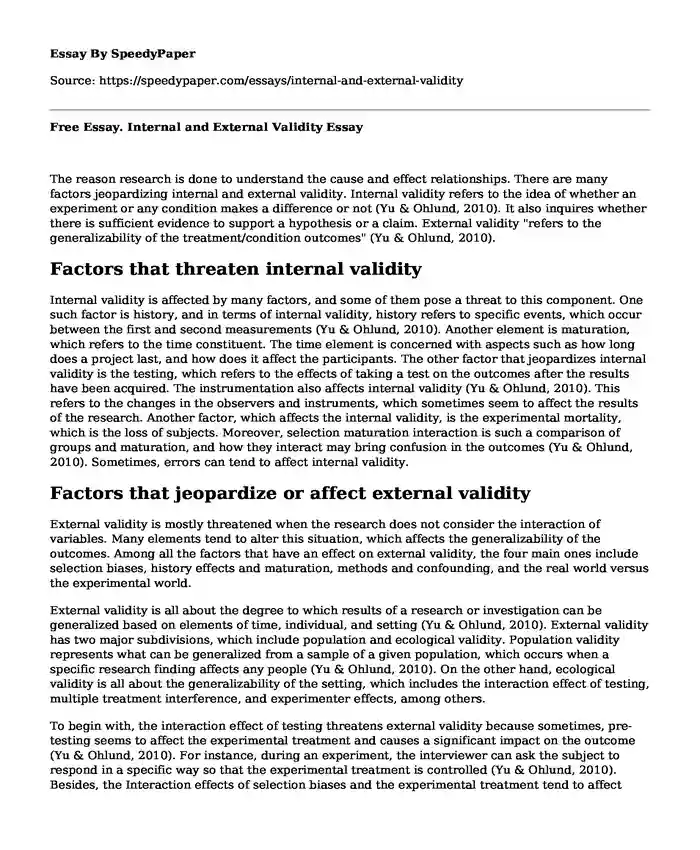The reason research is done to understand the cause and effect relationships. There are many factors jeopardizing internal and external validity. Internal validity refers to the idea of whether an experiment or any condition makes a difference or not (Yu & Ohlund, 2010). It also inquires whether there is sufficient evidence to support a hypothesis or a claim. External validity "refers to the generalizability of the treatment/condition outcomes" (Yu & Ohlund, 2010).
Factors that threaten internal validity
Internal validity is affected by many factors, and some of them pose a threat to this component. One such factor is history, and in terms of internal validity, history refers to specific events, which occur between the first and second measurements (Yu & Ohlund, 2010). Another element is maturation, which refers to the time constituent. The time element is concerned with aspects such as how long does a project last, and how does it affect the participants. The other factor that jeopardizes internal validity is the testing, which refers to the effects of taking a test on the outcomes after the results have been acquired. The instrumentation also affects internal validity (Yu & Ohlund, 2010). This refers to the changes in the observers and instruments, which sometimes seem to affect the results of the research. Another factor, which affects the internal validity, is the experimental mortality, which is the loss of subjects. Moreover, selection maturation interaction is such a comparison of groups and maturation, and how they interact may bring confusion in the outcomes (Yu & Ohlund, 2010). Sometimes, errors can tend to affect internal validity.
Factors that jeopardize or affect external validity
External validity is mostly threatened when the research does not consider the interaction of variables. Many elements tend to alter this situation, which affects the generalizability of the outcomes. Among all the factors that have an effect on external validity, the four main ones include selection biases, history effects and maturation, methods and confounding, and the real world versus the experimental world.
External validity is all about the degree to which results of a research or investigation can be generalized based on elements of time, individual, and setting (Yu & Ohlund, 2010). External validity has two major subdivisions, which include population and ecological validity. Population validity represents what can be generalized from a sample of a given population, which occurs when a specific research finding affects any people (Yu & Ohlund, 2010). On the other hand, ecological validity is all about the generalizability of the setting, which includes the interaction effect of testing, multiple treatment interference, and experimenter effects, among others.
To begin with, the interaction effect of testing threatens external validity because sometimes, pre-testing seems to affect the experimental treatment and causes a significant impact on the outcome (Yu & Ohlund, 2010). For instance, during an experiment, the interviewer can ask the subject to respond in a specific way so that the experimental treatment is controlled (Yu & Ohlund, 2010). Besides, the Interaction effects of selection biases and the experimental treatment tend to affect selection factors, and if groups were selected randomly, the results would be affected (Yu & Ohlund, 2010). A good example, in this case, is when the results are used with a class or let's say low achievers, and no generalization is used in this case.
Multiple treatment interference, which means the same subjects receive more than two treatments, also affects external validity. In this situation, it is hard to generalize one element since there are two possible outcomes (Yu & Ohlund, 2010).
In conclusion, internal and external validity may sometime have errors, and that is where the difference in measurements tends to occur. Internal validity is mostly free from errors, while external validity seems to have the most accurate experiment results. Nonetheless, both elements are affected by many factors, which may jeopardize the results.
References
Yu, C. H., & Ohlund, B. (2010). Threats to validity of research design. Retrieved January 12, 2012.
Cite this page
Free Essay. Internal and External Validity. (2023, Mar 23). Retrieved from https://speedypaper.net/essays/internal-and-external-validity
Request Removal
If you are the original author of this essay and no longer wish to have it published on the SpeedyPaper website, please click below to request its removal:
- Essay Sample on the Fictional Story on Lwanda Magere
- Research Paper Example on Virtual Games That Help Manage Diabetes
- Personality Disorder Essay Sample
- Essay Sample on Wage Gap Between Male and Female CEOs of Fortune 500 Companies
- Essay Example: Alternate Sources of Energy
- Essay Sample on Fredrick Douglass and Mary Wollstonecraft Similarities
- Exploring Hydroxychloroquine: Uses, Controversies, and Ethical Concerns in the COVID-19 Era - Free Essay
Popular categories





